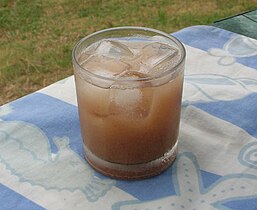Limonia acidissima
| Limonia acidissima | |
|---|---|

| |
| In Trincomalee, Sri Lanka | |
| Scientific classification | |
| Kingdom: | Plantae |
| Clade: | Tracheophytes |
| Clade: | Angiosperms |
| Clade: | Eudicots |
| Clade: | Rosids |
| Order: | Sapindales |
| Family: | Rutaceae |
| Subfamily: | Aurantioideae |
| Genus: | Limonia L. |
| Species: | L. acidissima
|
| Binomial name | |
| Limonia acidissima L.
| |
| Synonyms | |
|
Genus:[1]
Species:[2]
| |
Limonia acidissima is the only species within the monotypic genus Limonia. Common names for the species in English include wood-apple and elephant-apple.[3] It is sometimes also called monkey fruit.
Description
[edit]Limonia acidissima is a large tree growing to 9 metres (30 ft) tall, with rough, spiny bark. The leaves are pinnate, with 5-7 leaflets, each leaflet 25–35 mm long and 10–20 mm broad, with a citrus-scent when crushed. The flowers are white and have five petals. The fruit is a berry 5–9 cm diameter, and may be sweet or sour. It has a very hard rind which can be difficult to crack open, it appears greenish-brown in colour from outside and contains sticky brown pulp and small white seeds. The fruit looks similar in appearance to the Bael fruit (Aegle marmelos). It contains considerable amount of protein, carbohydrate, iron, fat, calcium, Vit-B & C etc. 100 g of ripe fruit pulp contains up to 49 KCal.
Taxonomy
[edit]A number of other species formerly included in the genus are now treated in the related genera Atalantia, Citropsis, Citrus, Glycosmis, Luvunga, Murraya, Micromelum, Naringi, Pamburus, Pleiospermium, Severinia, Skimmia, Swinglea, and Triphasia.[4]
Distribution
[edit]Limonia acidissima is native to India (including the Andaman Islands), Bangladesh, and Sri Lanka.[5][6] The species has also been introduced to Indochina and Malesia.[6][5]
Uses
[edit]The fruit is used to make a fruit juice with astringent properties and jams. Ripe fruit can be used as pickle (mashed with green chili pepper, sugar and salt only).[7]
In some parts of India, mainly Gujarat, the fruit pulp is used to make chutney which is then used as a main condiment in and on top of meals, especially in winter.[citation needed]
In Myanmar, the wood is used to make the distinctive local face cream thanaka.[8]
Nutrition
[edit]| Nutritional value per 100 g (3.5 oz) | |||||||||||||||||||||||||||||||||||
|---|---|---|---|---|---|---|---|---|---|---|---|---|---|---|---|---|---|---|---|---|---|---|---|---|---|---|---|---|---|---|---|---|---|---|---|
| Energy | 518.816 kJ (124.000 kcal) | ||||||||||||||||||||||||||||||||||
18.1 g | |||||||||||||||||||||||||||||||||||
| Sugars | 0 g | ||||||||||||||||||||||||||||||||||
| Dietary fiber | 5 g | ||||||||||||||||||||||||||||||||||
3.7 g | |||||||||||||||||||||||||||||||||||
7.1 g | |||||||||||||||||||||||||||||||||||
| |||||||||||||||||||||||||||||||||||
| Other constituents | Quantity | ||||||||||||||||||||||||||||||||||
| Water | 64.2 g | ||||||||||||||||||||||||||||||||||
in Fruit Wood Apple
values are for edible portion | |||||||||||||||||||||||||||||||||||
| †Percentages estimated using US recommendations for adults,[9] except for potassium, which is estimated based on expert recommendation from the National Academies.[10] Source: 1 | |||||||||||||||||||||||||||||||||||
Gallery
[edit]-
Woodapple fruit
-
Opened woodapple fruit
-
A glass of woodapple juice
References
[edit]- ^ "Limonia L." Plants of the World Online. Royal Botanic Gardens, Kew. Retrieved 2021-09-14.
- ^ "Limonia acidissima L." Plants of the World Online. Royal Botanic Gardens, Kew. Retrieved 2021-09-14.
- ^ "Limonia acidissima". Germplasm Resources Information Network. Agricultural Research Service, United States Department of Agriculture. Retrieved 2016-04-03.
- ^ John H. Wiersema (2005-02-22). "Species in GRIN for genus". Ars-grin.gov. Archived from the original on 2000-11-02. Retrieved 2011-04-19.
- ^ a b "Limonia acidissima L." Plants of the World Online. Royal Botanic Gardens, Kew. Retrieved 2018-03-25.
- ^ a b Smith, Albert C. (1985). Flora Vitiensis nova : a new Flora of Fiji (spermatophytes only). Vol. 3. Lawaii, Hawaii: Pacific Tropical Botanical Garden. pp. 526–527. Retrieved 2018-03-25 – via Biodiversity Heritage Library, digitized by Smithsonian Libraries.
- ^ Jaya Surya Kumari Manthena and K. Mythili (2004). "Development of wood apple pickle". Int. J. Food Safety, Nutrition and Public Health, Vol. 5, No. 1, 2014. Retrieved 2019-06-09.
- ^ Köllner, Helmut; Bruns, Axel (1998). Myanmar (Burma). Hunter Publishing. p. 18. ISBN 9783886184156. Retrieved 2021-05-08.
- ^ United States Food and Drug Administration (2024). "Daily Value on the Nutrition and Supplement Facts Labels". FDA. Archived from the original on 2024-03-27. Retrieved 2024-03-28.
- ^ National Academies of Sciences, Engineering, and Medicine; Health and Medicine Division; Food and Nutrition Board; Committee to Review the Dietary Reference Intakes for Sodium and Potassium (2019). Oria, Maria; Harrison, Meghan; Stallings, Virginia A. (eds.). Dietary Reference Intakes for Sodium and Potassium. The National Academies Collection: Reports funded by National Institutes of Health. Washington, DC: National Academies Press (US). ISBN 978-0-309-48834-1. PMID 30844154. Archived from the original on 2024-05-09. Retrieved 2024-06-21.
External links
[edit] Media related to Limonia acidissima at Wikimedia Commons
Media related to Limonia acidissima at Wikimedia Commons- Purdue-hort_edu: The Wood Apple
- Pandanus Database - Limonia



